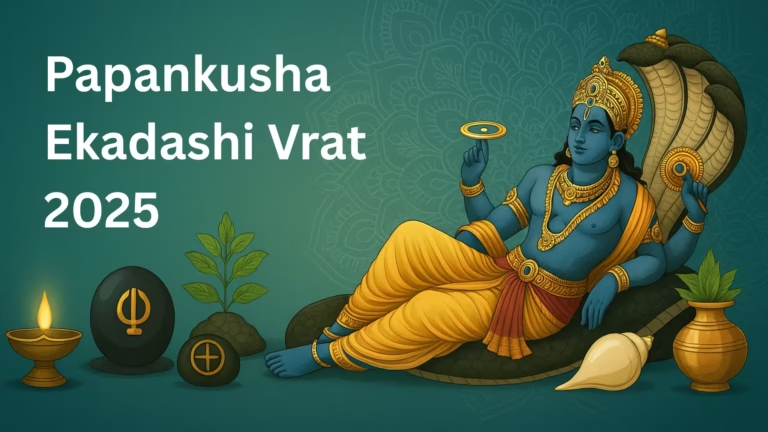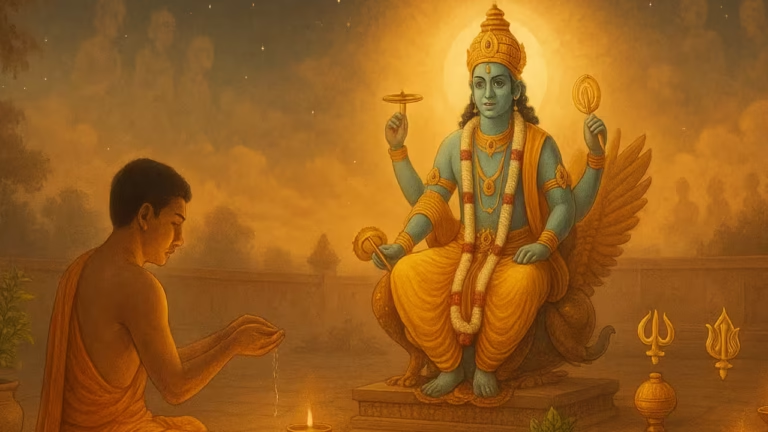Table of Contents
When is Ashadhi Ekadashi in 2025?
Ashadhi Ekadashi, also known as Devshayani Ashadhi Ekadashi, holds immense significance in the Hindu religious calendar, especially in the state of Maharashtra and regions where Lord Vitthal (Vithoba), a form of Lord Vishnu, is worshipped. It falls on the 11th lunar day (Ekadashi) of the bright fortnight of the Hindu month of Ashadha. In 2025, Devshayani Ekadashi will be observed on 6 July 2025, and the Parana (breaking the fast) will be observed on 7 July 2025.
Meaning of Devshayani Ashadhi Ekadashi
The term ‘Devshayani Ekadashi’ is derived from two Sanskrit words — Dev meaning “divine” or “God” and Shayani meaning “to sleep.” According to Hindu scriptures like the Skanda Purana and the Padma Purana, this day marks the beginning of Lord Vishnu’s cosmic slumber (yoganidra) on the serpent Sheshnag in the Kshira Sagara (ocean of milk). This state of rest continues for four months and is known as the Chaturmas period, during which most auspicious activities are avoided, and devotees commit to a more disciplined and spiritually-focused life.
Why is Devshayani Ashadhi Ekadashi Celebrated?
Devshayani Ekadashi commemorates the day when Lord Vishnu enters a meditative sleep state (yoganidra), marking the onset of the Chaturmas period. As per the Skanda Purana and Padma Purana, this period lasts for four months and is considered spiritually intensive. During this time, practices like marriage and housewarming are generally avoided, and people engage in vrat (fasts), worship, and austerities.
In Pandharpur (Maharashtra), the day is observed with great devotion where devotees take part in the Dindi Yatra, a spiritual procession led by Warkaris following the path of saints like Sant Tukaram and Sant Dnyaneshwar. The journey is a blend of spiritual discipline, social harmony, and devotion.
Significance of Devshayani Ashadhi Ekadashi
Devshayani Ashadhi Ekadashi marks the day when Lord Vishnu enters yoganidra (cosmic sleep), which initiates the four-month-long Chaturmas period as described in the Skanda Purana and Padma Purana. This date holds particular importance in regions where Lord Vishnu is worshipped in the form of Vitthal, especially in Pandharpur, Maharashtra. According to scriptural texts, Lord Vishnu rests on the serpent Sheshnag in the ocean of milk (Kshira Sagara) during this period, and this phase is dedicated to intense spiritual discipline, inner restraint, and devotional practices.
Every year, lakhs of devotees undertake a pilgrimage on foot to Pandharpur to have darshan of Lord Vitthal. The observance of this Ekadashi is not just a spiritual commitment but also a major cultural and social tradition. By observing the associated rituals and fasts, devotees align their lives with discipline, regular spiritual practices, and inner upliftment. This is why Devshayani Ekadashi is considered one of the most significant Ekadashis of the year.
Devshayani Ashadhi Ekadashi 2025 Date and Time
Devshayani Ashadhi Ekadashi in 2025 will be observed on Sunday, 6 July. The Ekadashi Tithi begins on the previous evening, Saturday, 5 July, at 6:58 PM and ends on Sunday, 6 July, at 9:14 PM. Those observing the fast should break it during the Parana period, which falls on Monday, 7 July, between 5:29 AM and 8:16 AM. The Dwadashi Tithi ends later that morning at 11:10 AM. These timings are based on the Hindu Panchang and must be followed carefully to ensure the fast is spiritually effective and performed according to tradition.
Rituals and Worship on Devshayani Ashadhi Ekadashi
d worship Lord Vishnu with sincerity and devotion. In Maharashtra, Lord Vitthal (Vithoba) and Goddess Rukmini (Rukhmai) are jointly worshipped. Key rituals include:
- Morning Rituals: Devotees rise early, take a bath, wear clean clothes, and perform puja at home or in temples. Thousands of devotees visit the Vitthal temple in Pandharpur.
- Fasting: Most devotees observe a strict nirjala (waterless) fast. Those unable to do so due to health reasons consume only fruits or milk.
- Mantra Chanting: Reciting the Vishnu mantra “Om Namo Bhagavate Vasudevaya” is considered highly beneficial.
- Temple Visit: Visiting Vishnu or Vitthal temples and participating in the aarti is believed to bring immense merit.
- Tulsi Offering: Devotees offer Tulsi leaves to the deity, which is prescribed in scriptures like the Padma Purana and Garuda Purana.
- Reading Scriptures: Devotees also engage in reading texts like the Bhagavad Gita, Vishnu Sahasranama, and Shrimad Bhagavatam.
Ashadhi Ekadashi Fasting Rules (Vrat)
No Food or Water: Devotees avoid all forms of food and water. If health does not permit, only satvik food like fruits or milk is consumed.
Avoid Tamasic Food: Items like meat, eggs, onion, garlic, alcohol, and tobacco are strictly prohibited.
Proper Parana Timing: Fast should be broken the next day after sunrise within the prescribed Dwadashi time. This is followed by Tulsi water offering and Vishnu puja.
Mental Discipline: Along with dietary restrictions, one must also practice restraint in speech, thought, and actions. Devotional activities and spiritual focus are key.
Why is Ashadhi Ekadashi Celebrated with Such Importance in Pandharpur?
The town of Pandharpur in Maharashtra holds a special place in the hearts of Devshayani Ekadashi devotees. It is believed that Lord Vishnu incarnates as Lord Vithoba in Pandharpur. Every year, thousands of pilgrims walk miles from various parts of Maharashtra to Pandharpur, singing devotional songs (Abhangas) and offering their prayers to Lord Vithoba. The devotion shown during Ashadhi Ekadashi has been a long-standing tradition, and the temple town becomes a sea of pilgrims during this time.
The importance of Ashadhi Ekadashi in Pandharpur is heightened due to the belief that Lord Vithoba himself is present here, and the rituals performed on this day bring immense spiritual benefits to the devotees.
Why is Devshayani Ekadashi Considered the Most Important?
Devshayani Ekadashi is regarded in the Vaishnava tradition as the most significant among all the 24 Ekadashis observed throughout the year. It is also referred to as ‘Maha Ekadashi’ or ‘Badi Ekadashi’. The reason for its special reverence is that on this day, Lord Vishnu is believed to enter yoganidra (cosmic sleep) on the serpent Sheshnag in the ocean of milk, marking the beginning of the holy Chaturmas period. As described in the Skanda Purana and Padma Purana, observing this Ekadashi brings stability of mind, strengthens one’s austerity (tapas), and deepens devotion. The worship performed on this day, along with disciplined conduct, serves as a powerful catalyst for spiritual progress.
read also: Shravan Maas 2025: Key Dates, Significance, and Fasting Rituals Explained
Mantras for Devshayani Ekadashi
During Devshayani Ekadashi, chanting the following mantras brings peace and blessings:
- “Om Namo Bhagavate Vasudevaya”
- “Om Shri Vithoba Namah”
- “Om Namo Narayanaya”
These mantras invoke the divine blessings of Lord Vishnu and Lord Vithoba, purifying the mind and bringing spiritual enlightenment.
Conclusion: How to Perform Lord Vithoba’s Pooja on Devshayani Ekadashi
Performing the Lord Vithoba pooja on this day is a cherished practice. To perform the pooja:
- Cleanse the Space: Clean your house or temple space before beginning the pooja.
- Offer Flowers and Tulsi Leaves: Place fresh flowers and Tulsi leaves on the idol or image of Lord Vithoba.
- Recite Mantras: Chant the mantras while offering prayers, followed by the singing of devotional songs.
- Offer Prasadam: Offer sweets, fruits, and light a lamp as part of the pooja.
The pooja concludes with the devotional song “Panduranga Vithoba”, and devotees take the prasad, signifying the blessings of the deity.
click here to read in hindi: कब है देवशयनी आषाढी एकादशी? जानिए पूजा विधि, सही समय और नियम!



